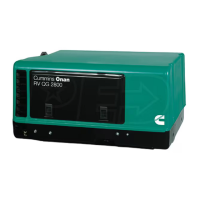2.
3.
4.
Disconnect the ignition shut down circuit by locat-
ing relay
K3
(Figure 7-3) and removing leads G2-1
and S2-1 from
K3-30.
Separate piggy backed leads
G2-1 and S2-1 and insulate them from each other
and from ground.
Remove the spark plug, reconnect the spark plug
lead and ground the plug side electrode to bare
metal on the engine.
Do
not touch the plug or plug wire during testing.
Crank the engine and observe the plug.
A
good
spark should be observed.
If
no spark is observed,
the magneto or wires connected
to
the magneto are
the most likely cause. Refer
to
the Generatorsection
for generator disassembly
to
access the magneto
assembly.
CRANKCASE
VENTILATION
SYSTEM
The crankcase breather prevents pressure from build-
ing up in the crankcase.
It
also prevents oil contamina-
tion by removing moisture or gasoline vapors and other
harmful blow-by materials from the crankcase. These
vapors are routed
to
the carburetor where they are
mixed with the incoming air and burned in the combus-
tion chamber.
A
sticky breather valve can cause oil
leaks, high oil consumption, rough idle, reduced engine
power, and a rapid formation of sludge and varnish
within the engine.
Crankcase Breather Service
If
the crankcase becomes pressurized, as
evidenced by
oil
leaks at the seals, use the following
procedures to service.
Remove the breather tube and the head cover (see
Engine Block Assembly, Section
9)
then remove the
breather from the cylinder head and inspect it. The reed
valve must be flat with no sign of creases or other
damage.
If
the breather is defective, replace it.
If
the
breather is dirty, clean it in parts cleaning solvent.
Most parts cleaning solvents are
flammable and can result in severe
personal injury
if
used improperly. Follow the manu-
facturer’s recommendations when cleaning parts.
Check breather tube and air passages for clogging and
clean as required.
GOVERNOR
The governor controls engine speed which directly
affects the voltage output and frequency
of
the genera-
tor. An increase in engine speed will cause a corres-
ponding increase in generator voltage and frequency. A
decrease in engine speed will cause a corresponding
decrease in generator voltage and frequency. The gov-
ernor maintains a constant engine speed under chang-
ing load conditions
so
that generator voltage and fre-
quency do not vary.
Governor Adjustments
Contact with moving parts can cause
severe personalinjury Keep clothing,
jewelry, bands, and fingers dear while adjusfing the
governor.
4
A hof generator set can cause severe
burns. Always allow fhe generator
set to cool before touching any components
or
remov-
ing any parts.
Before making governor adjustments, run the unit about
15 minutes under 50percent load
to
reach normal oper-
ating temperature.
If
governor is completely out of
adjustment, makea preliminary adjustment at no load to
first attain a safe voltage and speed operating range.
An accurate voltmeter and frequency meter should be
connected to the generator in order to correctly adjust
the governor (accuracy
of
0.3%
on frequency and
0.5%
on voltage).
A
small speed drop not noticeable without
instruments will cause an objectionable voltage drop.
A
binding in the governor shaft, governor linkage, or
carburetor throttle will cause erratic governor action or
alternate increase and decrease in the engine speed
(hunting).
A
rich or lean carburetor adjustment can
cause hunting and a fouled spark plug can cause miss-
ing and hunting. Springs tend
to
lose their calibrated
tension through fatigue and after long usage and may
require replacement.
If the governor action is erratic after adjustments are
made, replace the spring.
If
this does not improve opera-
tion, the problem may be within the governor mecha-
nism (see Engine Block Assembly, section
9).
Adjustments
to
the governor should be made in the
following sequence.
The carburetor fuel mixture screws must be cor-
rectly adjusted before governor adjustments are
made.
If
the carburetor needs adjusting, refer
to
the
Mixture Screw Adjustments in this section before
making any adjustments to the governor.
Set the carburetor throttle stop screw as specified in
Carburetor Mixture Screw Adjustments (step
5).
Check the governor linkage for binding or exces-
sive looseness. Check the motion spring for bend-
ing or damage and straighten or replace as needed.
With unit operating at no-load, adjust the speed
adjustment screw (see Figure 6-6) on the governor
linkage
to
obtain 62.5
f
0.5
Hz, at between 120 and
126 volts on 60 hertz units. Set
50
hertz units to
obtain 52.0
k
0.5
Hz
at between 220 and 231 volts
for
220
volt units and
240
to
252
volts for
240
volt
units.
6-1
0

